外研版小学英语18册知识点复习及语法
(完整word版)外研版小学英语语法总复习知识点归纳
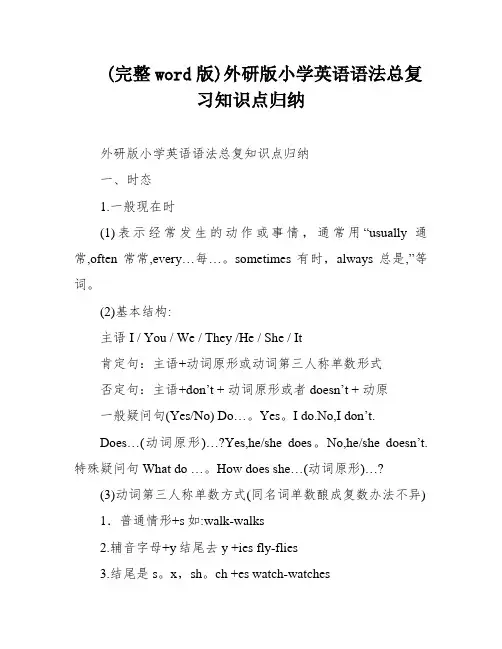
(完整word版)外研版小学英语语法总复习知识点归纳外研版小学英语语法总复知识点归纳一、时态1.一般现在时(1)表示经常发生的动作或事情,通常用“usually通常,often常常,every…每…。
sometimes有时,always总是,”等词。
(2)基本结构:主语I / You / We / They /He / She / It肯定句:主语+动词原形或动词第三人称单数形式否定句:主语+don’t + 动词原形或者doesn’t + 动原一般疑问句(Yes/No) Do…。
Yes。
I do.No,I don’t.Does…(动词原形)…?Yes,he/she does。
No,he/she doesn’t.特殊疑问句What do …。
How does she…(动词原形)…?(3)动词第三人称单数方式(同名词单数酿成复数办法不异)1.普通情形+s如:walk-walks2.辅音字母+y结尾去y +ies fly-flies3.结尾是s。
x,sh。
ch +es watch-watches4.结尾是0 +es do-does。
go-goes5.特殊have-has2.现在进行时(1)表示正在发生的动作,通常用“now现在。
look看,XXX听”.(2)根本方式: be +动词-ingeg: I am(not) XXX.You/We/They are(not) reading。
He/She/It is(not) eating.What are you doing。
Is he reading?(3)动词的目前分词方式(动词+ing)普通情形+ing walk—walking末端是不发音的e-e+ingcome—coming重读闭音节双写末了一个字母+ingswim-swimming。
run-running3.一般过去时(1)表示过去已经发生的事情,通常用“last …上一个…。
just now刚才,many years ago许多年前,XXX昨天”等词。
外研社小学英语知识点归纳
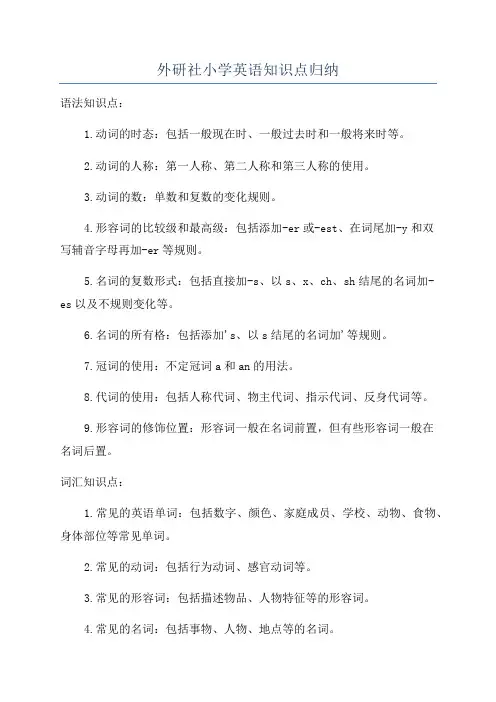
外研社小学英语知识点归纳语法知识点:1.动词的时态:包括一般现在时、一般过去时和一般将来时等。
2.动词的人称:第一人称、第二人称和第三人称的使用。
3.动词的数:单数和复数的变化规则。
4.形容词的比较级和最高级:包括添加-er或-est、在词尾加-y和双写辅音字母再加-er等规则。
5.名词的复数形式:包括直接加-s、以s、x、ch、sh结尾的名词加-es以及不规则变化等。
6.名词的所有格:包括添加's、以s结尾的名词加'等规则。
7.冠词的使用:不定冠词a和an的用法。
8.代词的使用:包括人称代词、物主代词、指示代词、反身代词等。
9.形容词的修饰位置:形容词一般在名词前置,但有些形容词一般在名词后置。
词汇知识点:1.常见的英语单词:包括数字、颜色、家庭成员、学校、动物、食物、身体部位等常见单词。
2.常见的动词:包括行为动词、感官动词等。
3.常见的形容词:包括描述物品、人物特征等的形容词。
4.常见的名词:包括事物、人物、地点等的名词。
5.常见的副词:包括表示时间、地点、方式等的副词。
6.常见的连词:包括连接句子、词组、并列和对比等的连词。
句子结构和表达:1.陈述句的构成和基本结构:主语+谓语+宾语。
2.疑问句的构成:包括一般疑问句、特殊疑问句等。
3.否定句的构成:一般在谓语动词前加not。
4.祈使句的构成:以动词开头,表示命令或请求。
5.感叹句的构成:以助词what或how开头,表示惊讶、赞美、遗憾等情感。
6.常见的句型:包括There is/are, I can/can't, I like/don't like等常见句型。
阅读技巧:1.辨别词义:通过上下文理解词义。
2.理解句意:通过关键词和句子结构等推断句意。
3.找主题句:通过段落的第一句或总结句等找到段落的中心思想。
4.理解标题:通过预测段落内容和文章整体思路等理解标题含义。
5.寻找信息:通过关键词、答案选项等快速找到问题的答案。
(word完整版)小学三至六年级英语语法及重点词汇(外研版)
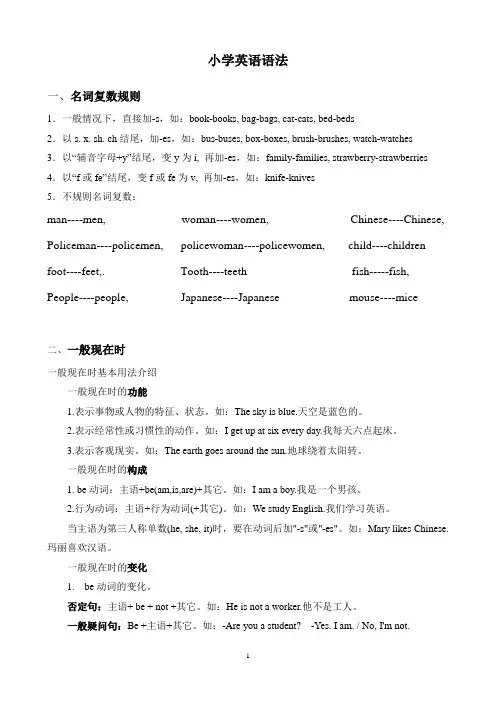
小学英语语法一、名词复数规则1.一般情况下,直接加-s,如:book-books, bag-bags, cat-cats, bed-beds2.以s. x. sh. ch结尾,加-es,如:bus-buses, box-boxes, brush-brushes, watch-watches3.以“辅音字母+y”结尾,变y为i, 再加-es,如:family-families, strawberry-strawberries 4.以“f或fe”结尾,变f或fe为v, 再加-es,如:knife-knives5.不规则名词复数:man----men, woman----women, Chinese----Chinese, Policeman----policemen, policewoman----policewomen, child----children foot----feet,. Tooth----teeth fish-----fish, People----people, Japanese----Japanese mouse----mice二、一般现在时一般现在时基本用法介绍一般现在时的功能1.表示事物或人物的特征、状态。
如:The sky is blue.天空是蓝色的。
2.表示经常性或习惯性的动作。
如:I get up at six every day.我每天六点起床。
3.表示客观现实。
如:The earth goes around the sun.地球绕着太阳转。
一般现在时的构成1. be动词:主语+be(am,is,are)+其它。
如:I am a boy.我是一个男孩。
2.行为动词:主语+行为动词(+其它)。
如:We study English.我们学习英语。
当主语为第三人称单数(he, she, it)时,要在动词后加"-s"或"-es"。
(完整版)外研版小学英语语法知识
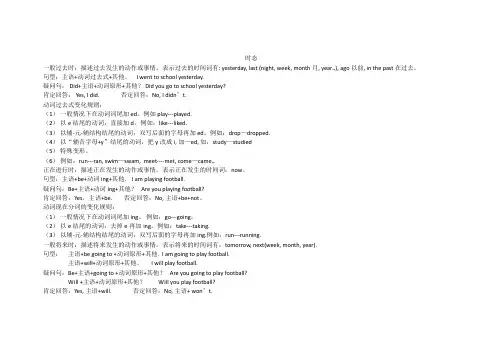
时态一般过去时:描述过去发生的动作或事情。
表示过去的时间词有: yesterday, last (night, week, month月, year…), ago以前, in the past 在过去。
句型:主语+动词过去式+其他。
I went to school yesterday.疑问句: Did+主语+动词原形+其他? Did you go to school yesterday?肯定回答: Yes, I did. 否定回答:No, I didn’t.动词过去式变化规则:(1)一般情况下在动词词尾加ed。
例如play---played.(2)以e结尾的动词,直接加d。
例如:like---liked.(3)以辅-元-辅结构结尾的动词,双写后面的字母再加ed。
例如:drop—dropped.(4)以“辅音字母+y”结尾的动词,把y改成i, 加—ed, 如:study—studied(5)特殊变形。
(6)例如:run---ran, swim—swam, meet----met, come—came…正在进行时:描述正在发生的动作或事情。
表示正在发生的时间词:now。
句型:主语+be+动词ing+其他. I am playing football.疑问句:Be+主语+动词ing+其他? Are you playing football?肯定回答:Yes,主语+be. 否定回答:No, 主语+be+not。
动词现在分词的变化规则:(1)一般情况下在动词词尾加ing。
例如:go---going。
(2)以e结尾的动词,去掉e再加ing。
例如:take---taking.(3)以辅-元-辅结构结尾的动词,双写后面的字母再加ing.例如:run---running.一般将来时:描述将来发生的动作或事情。
表示将来的时间词有:tomorrow, next(week, month, year).句型:主语+be going to +动词原形+其他. I am going to play football.主语+will+动词原形+其他。
小学三至六年级英语语法及重点词汇(外研版)(精选五篇)
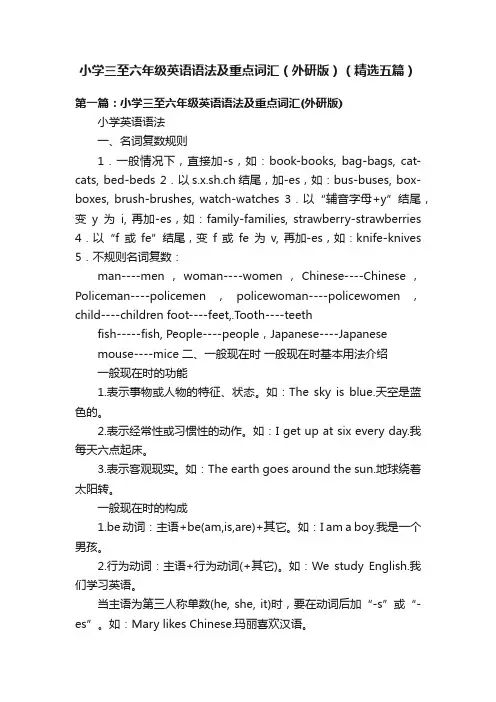
小学三至六年级英语语法及重点词汇(外研版)(精选五篇)第一篇:小学三至六年级英语语法及重点词汇(外研版)小学英语语法一、名词复数规则1.一般情况下,直接加-s,如:book-books, bag-bags, cat-cats, bed-beds 2.以s.x.sh.ch结尾,加-es,如:bus-buses, box-boxes, brush-brushes, watch-watches 3.以“辅音字母+y”结尾,变y为i, 再加-es,如:family-families, strawberry-strawberries 4.以“f或fe”结尾,变f或fe为v, 再加-es,如:knife-knives 5.不规则名词复数:man----men,woman----women,Chinese----Chinese,Policeman----policemen,policewoman----policewomen,child----children foot----feet,.T ooth----teethfish-----fish, People----people,Japanese----Japanesemouse----mice 二、一般现在时一般现在时基本用法介绍一般现在时的功能1.表示事物或人物的特征、状态。
如:The sky is blue.天空是蓝色的。
2.表示经常性或习惯性的动作。
如:I get up at six every day.我每天六点起床。
3.表示客观现实。
如:The earth goes around the sun.地球绕着太阳转。
一般现在时的构成1.be动词:主语+be(am,is,are)+其它。
如:I am a boy.我是一个男孩。
2.行为动词:主语+行为动词(+其它)。
如:We study English.我们学习英语。
当主语为第三人称单数(he, she, it)时,要在动词后加“-s”或“-es”。
外研版小学英语语法知识点汇总
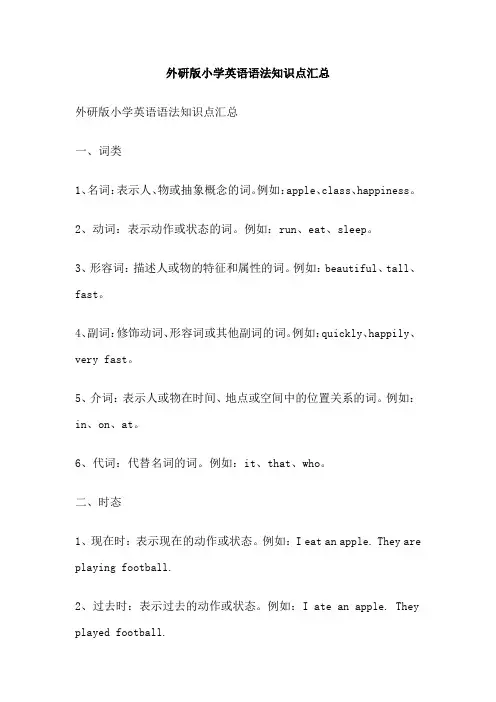
外研版小学英语语法知识点汇总外研版小学英语语法知识点汇总一、词类1、名词:表示人、物或抽象概念的词。
例如:apple、class、happiness。
2、动词:表示动作或状态的词。
例如:run、eat、sleep。
3、形容词:描述人或物的特征和属性的词。
例如:beautiful、tall、fast。
4、副词:修饰动词、形容词或其他副词的词。
例如:quickly、happily、very fast。
5、介词:表示人或物在时间、地点或空间中的位置关系的词。
例如:in、on、at。
6、代词:代替名词的词。
例如:it、that、who。
二、时态1、现在时:表示现在的动作或状态。
例如:I eat an apple. They are playing football.2、过去时:表示过去的动作或状态。
例如:I ate an apple. They played football.3、现在进行时:表示现在正在进行的动作或状态。
例如:I am eating an apple. They are playing football.4、过去进行时:表示过去正在进行的动作或状态。
例如:I was eating an apple. They were playing football.5、现在完成时:表示已经完成的动作或状态,强调结果。
例如:I have eaten an apple. They have played football.6、过去完成时:表示在过去某个时间之前已经完成的动作或状态。
例如:I had eaten an apple. They had played football.三、句子结构1、主语+谓语:最基本的句子结构,表示一个动作或状态。
例如:I jump. They run.2、主语+谓语+宾语:表示一个动作或行为及其对象。
例如:I eat an apple. They play football.3、主语+谓语+间接宾语+直接宾语:表示一个动作或行为及其间接对象和直接对象。
2023年外研版小学英语语法总复习知识点归纳
2023年外研版小学英语语法总复习知识
点归纳
1. 名词
- 单数名词和复数名词形式变化规则
- 可数名词和不可数名词的区别及用法
2. 代词
- 人称代词的主格、宾格和形式变化规则
- 物主代词的形式和用法
- 反身代词的形式和用法
3. 动词
- 动词的基本形式、第三人称单数形式和现在分词形式变化规则
- 一般现在时和现在进行时的用法
- 常用动词的不规则变化形式
4. 形容词和副词
- 形容词的比较级和最高级形式变化规则
- 副词的基本形式和比较级形式变化规则
- 形容词和副词的用法区别及常见词汇
5. 冠词
- 定冠词和不定冠词的用法和区别
6. 介词
- 常用介词的用法及搭配
- 介词短语的常见用法
7. 连词
- 并列连词的用法和连接两个主语、谓语或宾语- 从属连词的用法和连接主句和从句
8. 句型和句子结构
- 简单句的基本结构和常见句型
- 复合句的构成和常见句型
- 句子成分的基本分类和识别方法
9. 时态和语态
- 一般过去时、一般将来时和一般过去将来时的用法
- 被动语态的构成和用法
10. 反义疑问句和特殊疑问句
- 反义疑问句的构成和用法
- 特殊疑问词的用法及回答方式
11. 直接引语和间接引语
- 直接引语的转述和标点使用
- 间接引语的构成和变化
以上是2023年外研版小学英语语法总复的知识点归纳,希望能对你的研究有所帮助。
外研版小学英语重点知识汇总(版)
外研版小学英语重点知识汇总第一册(三年级上)一、词汇常用物品:door,window, desk,chair, blackboard, schoolbag,pencil, pen, book ,cap, present, cake, ball, kite(门,窗,桌子,椅子,黑板,书包,铅笔,钢笔,书,帽子,礼物,蛋糕,球,风筝)颜色:red, blue, yellow, green, black(红色,蓝色,黄色,绿色,黑色)动物:panda, dog, cat, bird, chameleon(熊猫,狗,猫,鸟,变色龙)数字:one, two, three,four, five,six, seven, eight, nine, ten,eleven,twelve(一,二,三,四,五,六,七,八,九,十,十一,十二)身体器官:head, leg, foot, arm, hand, nose, eye, mouth, ear(头,腿,脚,手臂,手,眼睛,鼻子,嘴巴,耳朵)家庭成员:mother, father, grandpa, grandma, sister, brother(妈妈,爸爸,爷爷,奶奶,姐姐,弟弟)职业:teacher, pupil, doctor, driver, nurse, farmer, policeman(老师,学生,医生,护士,司机,农民,警察)代词:I, you, it, me, he, she, your, my, his, her, this, that (我,你,它,我,他,她,你的,我的,他的,她的,这个,那个)二、句型1、打招呼及问好:Hello!(你好)Hi!(你好)早上见面说:Good morning.(上午好!)下午见面说:Good afternoon.(下午好!)跟人道别语:Goodbye.(再见)Byebye.(再见)跟人道谢语:Thank you!(谢谢你!)Thanks!(多谢)询问对方的身体情况:----How are you? (你好吗?)----I’m fine, thank you.(我很好,谢谢你。
外研版小学英语册知识点复习及语法
外研版小学英语册知识点复习及语法一、词汇1.数字:从1到100的基础数字,以及相关的词汇如月份、星期几等。
2.常见名词:食物、动物、颜色、家庭成员等。
3. 动词:基本动词如be动词、have动词、go动词等,以及一些常见动作词如run、eat、drink等。
4.形容词:描述事物的特征,如大、小、高、矮、快、慢等。
5.副词:描述动作的方式,如慢慢地、快快地等。
6. 介词:表示方位、时间、原因等,如in、on、under、after等。
7. 代词:主要有人称代词如I、you、he、she等,以及物主代词如my、your、his、her等。
8.句型:句型是句子的基本组成部分,外研版小学英语教材注重句型的学习和练习。
常见的句型有疑问句、陈述句、肯定句、否定句等。
二、语法1. 一般现在时:用于描述事物的常态或经常性动作。
一般现在时的肯定句结构:主语 + 动词原形。
否定句结构:主语 + 动词原形 + not。
疑问句结构:助动词do/does + 主语 + 动词原形。
2. 一般过去时:用于描述过去发生的动作或状态。
一般过去时的肯定句结构:主语 + 动词过去式。
否定句结构:主语 + did not + 动词原形。
疑问句结构:Did + 主语 + 动词原形?3. 现在进行时:用于描述当前正在进行的动作。
现在进行时的肯定句结构:主语 + am/is/are + 动词-ing。
否定句结构:主语 +am/is/are + not + 动词-ing。
疑问句结构:Am/Is/Are + 主语 + 动词-ing?4. 一般将来时:用于描述将来要发生的动作。
一般将来时的肯定句结构:主语 + will + 动词原形。
否定句结构:主语 + will not/won't + 动词原形。
疑问句结构:Will + 主语 + 动词原形?5. 有动词的词组:外研版小学英语教材中还涉及到了一些有特定意义的动词词组,如can、could、shall、should等。
外研社小学英语知识总结
外研社小学英语知识总结外研社小学英语篇一:外研社小学英语知识点归纳英语知识点Therebe句型:一般现在时:thereis+名词单数Thereare+名词复数一般过去时:therewas+名词单数Therewere+名词复数对事物提问用“what”(什么)对地点提问用“where”(哪里)对人物提问用“who”(谁)特殊疑问句的结构:动词WherecanWhen助动词+主语+其它WhoHow一般疑问句的结构:be动词Can提前+主语+其它助动词时态:lastnight/yesterday/tonight/tomorrow),再考虑动词用合适的时态。
人称:主语是第三人称单数(如:he/she/it),动词用单三形式(一般加s,以o/s/ch/zh/sh结尾的加es)否定句:be动词/can/助动词+not+动词原形:can/will/助动词+动词原形动词的过去式:一般+ed特殊:is—was am---was are---were do—did learn---learntLive—lived teach—taught write---wrote give---gave buy—bought Have/has---had make---made go---went send—sent ride—rode study--studied反义词:small—big light—heavy easy—hard white—black new—broken good—bad名词复数:一般+s以s/o/sh/ch/zh结尾的+es特殊的:child—children短语:talkabout谈论关于howabout怎么样lookat看一看in the field在田地里 everyday每天 many years ago许多年以前 have got有 study hard努力学习 like doing喜欢做by bus乘坐公交车 lots of许多go to school去学校 at school在学校 giveto把给Vevry much非常be going to do将要做make a cake做蛋糕 sendto把发送到a good idea一个好主意putto把放在上 library card 图书卡 foreign language外语 as well又、还、也want的用法:want+名词想要want to do sth.想要做某事some与any的区别:some用于肯定句any用于否定句或疑问句外研社小学英语篇二:外研社小学英语按性质分类单词总汇外研社小学英语分类单词总汇一、动物(animal):bird鸟 bear熊 horse马 butterfly蝴蝶 parrot鹦鹉 kangaroo袋鼠 cat 猫 chameleon变色龙 dog狗 camel骆驼chick小鸡 dragon龙 duck鸭子elephant大象 fish鱼 frog青蛙 hen母鸡 lion狮子 monkey猴子 owl猫头鹰panda熊猫 tiger老虎 wolf狼二、人体器官(body):head头 eye眼睛 ear耳朵face脸 nose鼻子 mouth嘴 hair头发 shoulder 肩膀 arm胳膊 hand手 finger手指 leg大腿 knee膝盖 foot脚(feet复数)toe脚趾三、季节(season):spring春天 summer夏天 autumn秋天 winter冬天四、月份(month):January一月 February二月 March三月 April四月 May五月 June六月July七月 August八月 September九月 October十月 November十一月 December 十二月五、星期(week):Sunday星期日 Monday星期一 Tuesday星期二 Wednesday星期三 Thursday 星期四 Friday星期五 Saturday星期六六、职业(job/work):actor演员 doctor医生 driver司机 dancer舞蹈演员 farmer农民 postman 邮递员 firemen消防队员 teacher教师 nurse护士 policeman警察 taikonaut 宇航员七、家庭(family):Grandparent(外)祖父(母)grandfather(外)祖父grandmother(外)祖母grandchildren(外)孙子(女)parent父(母)亲father父亲mother(mum)母亲cousin表(堂)兄妹kid孩子brother哥(弟)sister姐(妹)son儿子uncle叔,伯,舅八、国家(county):China中国France法国America美国Spain西班牙Australia澳大利亚Canada加拿大England英格兰九、城市(city)及场所(place):Chinatown唐人街bedroom卧室classroom教室farm农场field田地flat公寓house家,房子station车站supermarket超市library图书馆restaurant饭店,旅馆school学校office办公室park公园playground操场,运动场seashore海岸,海滩square广场十、水果(fruit):apple苹果banana香蕉watermelon西瓜mango芒果orange橘子pear梨peach桃子grape葡萄十一、服装(clothes):T-shirt体恤衫cap帽子coat外套hat帽子dress连衣裙,女装shoe鞋子sweater毛线衫swimsuit游泳衣十二、单位:Kilometer千米,公里kilo千克,公斤metre米十三、动作(action):dancing跳舞drawing画jumping跳skipping跳绳swimming游泳shipping购物十四、交通工具:aeroplane直升飞机bike自行车train火车bus公共汽车boat小船dragonboat龙船ship轮船car小汽车lorry卡车plane飞机taxi出租车十五、节日(festival):SpringFestival春节Lanternfestival元宵节DragonBoatfestival端午节Mid-AutumnFestival中秋节FlagDay国旗日Christmas圣诞节十六、三餐:breakfast早餐lunch午餐dinner晚餐,正餐十七、食品(food):fastfood快餐biscuit饼干bread面包cake蛋糕sausage火腿coffee咖啡cheese奶酪cola可乐dumplings饺子egg鸡蛋fishandchips 鱼和薯条mooncake月饼spice香料,调料品ginger姜hotdog热狗sweets 糖果hamburger汉堡包icecream冰激凌jam果酱peanut花生juice果汁meat肉milk牛奶sandwich三明治noodles面条soup汤soybeanmilk豆浆tea茶toast烤面包vegetable蔬菜十八、日用品:bed床bag包,袋bell铃bottle瓶子box盒子building建筑物basket篮子clock钟表camera照相机cup杯子chopsticks筷子door门vase花瓶doorbell门铃light灯pan平底锅phone电话radio收音机table桌子toothbrush牙刷knife刀chair椅子table桌子TV电视机telephone电话television电视机fork叉十九、游戏及娱乐:balloon气球jigsaw拼图游戏computergames电脑游戏joke笑话kite风筝morningexercise早操popularmusic流行音乐project综合实践项目toy 玩具二十、疾病:cold感冒fever高烧headache头痛stomachache胃痛二十一、学科(subject):maths数学geography地理history历史music音乐PE体育science科学French法语English英语Chinese汉语二十二、宇宙事物及天气(weather):sky天空air空气wind风cloud云sun太阳sunshine阳光space太空rain雨snow雪二十三、学习用品::blackboard黑板book书desk课桌dictionary字典pen钢笔pencil铅笔ruler尺子bag书包二十四、人物(people):boy男孩girl女孩friend朋友child儿童(单)children儿童(复)lady女士,小姐man男人(单)men男人(复)queen女王pupil小学生woman女人(单)women女人(复)二十五、球类名词(ball):basketball篮球baseball棒球football足球tabletennis乒乓球二十六、乐器名词:flute笛子guitar吉他piano钢琴trumpet小号violin小提琴cup杯子chopsticks筷子door门vase花瓶doorbell门铃light灯二十七、数词(numbers)one(一)two(二)three(三)four(四)five(五)six(六)seven(七)eight(八)nine (九)ten(十)eleven(十一)twelve(十二)thirteen(十三)fourteen(十四)fifteen(十五)sixteen(十六)seventeen(十七)eighteen(十八)nineteen(十九)twenty(二十)thirty(三十)forty(四十)fifty(五十)sixty(六十)seventy(七十)eighty(八十)ninety(九十)hundred(百)first(第一)second(第二)third(第三)fourth(第四)fifth(第五)sixth(第六)seventh(第七)eighth(第八)ninth(第九)tenth(第十)eleventh(第十一)twelfth(第十二)twentieth(第二十)二十八、形容词(adj.)good(好的)big(大的)small(小的)long(长的)tall(高的)short(短的,矮的) young(年轻的)old(旧的,老的)strong(健壮的)thin(瘦的)active(积极活跃的)quiet(安静的)kind(和蔼亲切的)strict(严格的)smart(聪明的)funny(滑稽可笑的)tasty(好吃的)sweet(甜的)salty(咸的)sour(酸的)favourite(最喜爱的)fresh(新鲜的)clean(干净的)tired(疲劳的)excited(兴奋的)angry(生气的,愤怒的)happy(高兴的)sad(忧愁的,悲伤的)bored(无聊的,烦人的)taller(更高的)shorter(更矮的)stronger(更强壮的)older(年龄更大的)younger(更年轻的)bigger(更大的)heavier(更重的)longer(更长的)thinner(更瘦的)smaller(更小的)nice(好看的)fine(好的)great(很好的)heavy(重的)new(新的)fat(胖的)happy(快乐的)right(对的)hungry(饥饿的)cute(逗人喜爱的)little(小的)lovely(可爱的)beautiful(漂亮的)colourful(色彩鲜艳的)pretty(漂亮的)cheap(便宜的)expensive(昂贵的)juicy(多汁的)tender(嫩的)healthy(健康的)ill(有病的)helpful(有帮助的)high(高的)easy(简单的)proud(骄傲的)sick(有病的)better(更好的)higher(更高的)二十九、介词(prep.)in(在里)on(在上,在时候)under(在下面)near(在旁边)behind(在后面)nextto(与相邻)at(在点钟)by(经乘)for(为,给)to(朝,向)over(在上方)infrontof(在前面) 三十、代词(pron.)I(我)mewe(我们)usyou(你,你们)youhe(他)himshe(她)herit(它)itthey(他/她/它们)themmy(我的)mineour(我们的)oursyour(你的,你们的)yourshis(他的)hisher(她的)hersthis(这,这个)that(那,那个)三十一、动词(v.)work(工作)play(玩,踢)swim(游泳)skate(滑冰)fly(飞)jump(跳)walk(走)run(跑)climb(往上爬)fight(打架)swing(荡)eat(吃)sleep(睡觉)like(像,喜欢)have(有,吃)turn(转弯)buy(买)take(买,带)live(居住)teach(教)stop(停,停车站)wait(等)study(学习)learn(学习)sing(唱歌)dance(跳舞)row(划)dohomework(做作业)watchTV(看电视)readbooks(读书)cookthemeals(做饭)watertheflowers(浇花)sweepthefloor(扫地)cleanthebedroom(打扫卧室)makethebed(铺床)setthetable(摆饭桌)washtheclothes(洗衣服)dothedishes(洗碗碟)useacomputer(使用计算机)eatbreakfast(吃早饭)eatdinner(吃晚饭)domorningexercises(晨练,做广播操)gotoschool(上学)playsports(进行体育运动)getup(起床)haveEnglishclass(上英语课)climbmountains(爬山)playthepiano(弹钢琴)flykites(放风筝)makeasnowman(堆雪人)pla(转载于::外研社小学英语)nttrees(种树)drawpictures(画画)cookdinner(做饭)readabook(看书)answerthephone(接电话)listentomusic(听音乐)cleantheroom(打扫房间)writealetter(写信)writeane-mail(写电子邮件)drinkwater(喝水)takepictures(照相)watchinsects(观察昆虫)pickupleaves(采摘树叶)doanexperiment(做实验)catchbutterflies(捉蝴蝶)countinsects(数昆虫)collectinsects(收集昆虫)collectleaves(收集树叶)writeareport(写报告)playchess(下棋)haveapicnic(举行野餐)getto(到达)rideabike(骑自行车)playtheviolin(拉小提琴)makekites(制作风筝)collectstamps(集邮)goshopping(买东西)goswimming(去游泳)gofishing(去钓鱼)gohiking(去远足)goskiing(去滑雪)goice-skating(去滑冰)visitgrandparents(看望祖父母/外祖父母)meet(见面)welcome(欢迎)thank(谢谢)love(爱)drink(喝)taste(尝)smell(闻)feed(喂养)shear(剪)milk(挤奶)look(看)guess(猜)help(帮助)pass(传递)show(展示)use(使用)clean(打扫)open(打开)close(关上)put(放)read(读)write(写)paint(绘画)tell(告诉)kick(踢)bounce(反弹)ride(骑)find(寻找)drive(驾驶)fold(折)send(寄)wash(洗)shine(照耀)become(变成)feel(感觉到)think(思考)fall(落下)leave(离开)wakeup(醒来)puton(穿上)takeoff(脱掉)hangup(挂起)wear(穿)gohome(回家)gotobed(上床睡觉)playcomputergames(玩电脑游戏)dohousework(做家务)emptythetrash(倒垃圾)putawaytheclothes(收拾衣服)getoff(下车)takeatrip(去旅行)readamagazine(阅读杂志)gotothecinema(去看电影)三十二、其他(others)day(天,日子)today(今天)date(日期)yes(是,是的)no(不,不是)not(不,不是的)o'clock(点钟)time(时间)here(这儿,这里)there(那儿,那里)very(很,非常)but(但是)then(然后)and(和)too(也,太)nextweek(下周)last(上一个,仅余的,留在最后的)noon(中午)evening(夜晚,晚上)please(请)usually(通常,一般)often(经常)sometimes(有时候)hobby(兴趣,爱好)best(最,极)because(因为)straightly(成直线地)birthday(生日)traffic(交通)trafficlight(交通灯)trafficrule(交通规则)matter(事情,麻烦)should(应该)comefrom(从来,来自)thismorning(今天上午)thisafternoon(今天下午)thisevening(今天晚上)三十三、动词的第三人称单数形式watch—watchesteach—teacheswash—washesgo—goesdo—doeshave—hasread—readslive—lives外研社小学英语篇三:(外研社版)小学英语语法大全(外研社版)小学英语语法大全第一章名词一、定义名词是表示人或事物名称的词。
- 1、下载文档前请自行甄别文档内容的完整性,平台不提供额外的编辑、内容补充、找答案等附加服务。
- 2、"仅部分预览"的文档,不可在线预览部分如存在完整性等问题,可反馈申请退款(可完整预览的文档不适用该条件!)。
- 3、如文档侵犯您的权益,请联系客服反馈,我们会尽快为您处理(人工客服工作时间:9:00-18:30)。
小学英语知识点归纳词汇:boy girl door window blackboard bird desk chair red blue yellow green black dog cat cap panda one two three four five six seven eight nine ten eleven twelve school teacher bag pencil pen book cake kite mother father grandpa grandma sister brother doctor driver policeman nurse farmer head arm leg foot nose eye mouth ear词汇:song toy car ship doll animal monkey tiger lion elephant big small fat thin tall short sport football basketball table tennis riding bikes swimming skipping meat rice noodles fish milk banana pear orange apple Chinese Maths Science Music Art PE play sleep sing give eat Christmas spring summer autumn winter hot warm cool cold sunny windy dress coat sweater T-shirt bike bus walk in on under park词组:get up go to school have lunch go home watch TVgo to bed have breakfast have dinner Spring Festival New Year fly kites go to work by bus by bike go fishing一、情境问答: 1. Have you got_______? Yes, I have. No, I haven’t.2. Excuse me. Where’s the________, please?A: Go straight on. B: Turn right. C: Turn left.3. What are you doing? I’m _______What is he/she doing? He’s/She’s ___________What are they doing? They’re __________4. Do you want some _______? Yes, please. No, thank you.5. Can you _____ ? Yes, I can. No, I can’t.6. What are you going to do? I’m/We’re going to _______7. Can I have some ______ ? Yes, you can. Sorry, you can’t.8. How many ____ are there in ____? There is/are______take pictures watch TV read a book make a cakewrite a letter listen to music talk to my friend do the high jump play with in the park look at do the long jump row a boat under the tree play chessplay football play basketball play table tennishave a picnic go swimming go to the park do homework speak English 情景运用:1. 问路、指路Excuse me. Where’s the _______, please?Go straight on. / Turn left. / Turn right.2.询问对方正在做什么What are you doing? I’m _______What is he/she doing? He’s/She’s ___________What are they doing? They’re __________3. 询问对方是否要吃某种食物Do you want some _______? Yes, please. No, thank you.4. 询问对方的能力Can you _____? Yes, I can. No, I can’t.5. 谈论将要做的事情What are you going to do? I’m/We’re going to _________6. 向别人要东西吃Can I have some ______ ? Yes, you can. Sorry, you can’t.7. 介绍某人This is_______8. 谈论周一至周日将要做的事What will you do on Monday? I’ll_______ on MondayWill you ______ on Monday? Yes, I will. No, I won’t.9. 做天气预报It will be hot/cold/sunny/windy. It will snow/rain.10. 做比较如: Sam is older than Daming.e backst Sunday/night/year3.go home4.go to school5.go to the park6.hurry up7.in a hurry8.wait for9.make a list 10.shopping list 11.half a kilo 12.how many 13.how much14.at the weekend 15.in the morning 16.in the afternoon 17.take a photo 18.take photos 19.the British Museum 20.Big Ben 21.the Great Wall22.the London Eye 23.give out 24.be careful 25.too many 26.run fast27.play football 28.half past seven 29.get up 30.sit down31.stand up 32.do morning exercises 33.play chess 34.on the farm 35.all day 36.of course 37.go out 38.say hello to 39.play basketball 40.play table tennis 41.many years ago 42.ten years ago 43.three days ago 44. live in 45.a lot of=lots of 46.watch TV 47.how about=what about 48.talk about 49.foreign language 50.study/work hard 51.an English teacher 52.a Chinese teacher 53.by bus/plane/car/train/ship/bike54.English/ Chinese food 55.at school /.at home 56.at the library57. library card 58.find out 59.be good at 60.look at 61.have /has got 62. in the east of China 63. in the west of China 64. in the south of China 65. in the north of China 66.every year/day 67.send an email68. a good idea 69.list小学英语语法及习题一、名词复数规则1.一般情况下,直接加-s,如:book-books, bag-bags, cat-cats, bed-beds2.以s. x. sh. ch结尾,加-es,如:bus-buses, box-boxes, brush-brushes, watch-watches 3.以“辅音字母+y”结尾,变y为i, 再加-es,如:family-families, strawberry-strawberries4.以“f或fe”结尾,变f或fe为v, 再加-es,如:knife-knives5.不规则名词复数:man-men, woman-women, policeman-policemen, policewoman-policewomen, mouse-micechild-children ,foot-feet, tooth-teeth,fish-fish, people-people, Chinese-Chinese, Japanese-Japanese写出下列各词的复数I _________him _________this ___________her ______watch _______child _______photo ________diary ______day________ foot________ book_______ dress ________tooth_______ sheep ______box_______ strawberry _____thief _______ peach______ sandwich ______man______ woman_______ paper_______ juice___________ water________ milk________ rice__________ tea__________二、一般现在时一般现在时基本用法介绍【No. 1】一般现在时的功能1.表示事物或人物的特征、状态。
